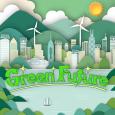內容
CONTENT
11/06/2025
相片集
Hong Kong's wetlands are primarily located near the Inner Deep Bay, with Mai Po designated as a Wetland of International Importance under the Ramsar Convention. Each year, over 100,000 waterbirds migrate to these wetlands to rest and refuel, including several globally endangered species.
Earlier this year, the Agriculture, Fisheries and Conservation Department (AFCD) launched public engagement activities for the proposed Sam Po Shue Wetland Conservation Park. However, environmental groups have raised concerns over recurring damage to protected wetlands in recent years, including illegal dumping and landfilling, which threaten bird habitats.
Over the years, the government has used various approaches to conserve wetlands. How can these experiences help in building a comprehensive wetland conservation park system in the future?
集數
EPISODES
-

Carbon Catchers
Emission reduction is urgent as global warming and extreme weather events ravage the world. Reducing greenhouse gas emissions has become a consensus among humans. "Absorbing" and "locking" carbon dioxide from the atmosphere, preventing its release back into the air, has become another new endeavor alongside emission reduction.
Simpler in structure than humans, microalgae, single-celled organisms that have existed in oceans and rivers for millions of years, are natural carbon absorption experts. Microalgae, invisible to the naked eye, are a few micrometers in size and, like trees, rely on photosynthesis for survival. During photosynthesis, microalgae's chlorophyll converts carbon dioxide into proteins, carbohydrates, and fats while producing oxygen, thereby helping to reduce greenhouse gases in the atmosphere.
Young research teams in Hong Kong have set up demonstration sites to cultivate and breed microalgae in specially designed tanks. They have devoted great effort and explored various methods to enhance the carbon absorption capacity of microalgae, with the goal of industrializing microalgae cultivation and promoting it worldwide. Local innovation and technology companies have also commercialized the "carbon absorption experts" by installing fluorescent green "microalgae reactors" in schools and other locations. These reactors use air pumps to draw air into water-filled containers to cultivate microalgae, aligning with organizations' carbon reduction goals under ESG reporting.
Microalgae may be the "carbon absorbers," but their life cycle is short, and they gradually release carbon dioxide back into the atmosphere. Scientists in other fields continue to unleash their unlimited creativity by attempting to directly "absorb" carbon dioxide from the air. Some Western countries have already invested in the construction of large-scale facilities to capture atmospheric carbon dioxide and store it underground. In Hong Kong, researchers at universities have made preliminary developments in the "carbon dioxide reduction system," which converts carbon dioxide into raw materials for plastic chemicals. In the future, this system could potentially be applied in industrial projects to promote carbon neutrality.
Of course, tree planting remains a crucial strategy for "carbon sequestration" at present. Trees naturally reduce carbon dioxide through photosynthesis. Environmental organizations collaborate with universities to study five different types of forests in various locations in Hong Kong. By measuring plant data using instruments after selecting suitable locations, they estimate the "carbon storage" of Hong Kong's forests and their potential for carbon dioxide removal. The aim is to assist the government in formulating policies to enhance the carbon absorption capacity of forests, ensuring that forests continue to serve as a major force for "carbon sequestration" in nature.
The extent of microalgae's carbon absorption capacity is still under research. Trees can store carbon dioxide in trees and soil for long periods. Can microalgae have a similar "carbon sequestration" effect? How effective is machine-based carbon capture? These questions still require further exploration by the academic and environmental sectors.16/07/2025收看 -

Waste Into Watts
Hong Kong generates around 11,000 tonnes of municipal solid waste (MSW) daily, most of which ends up in landfills. With limited land resources and ever-increasing waste, landfills are approaching full capacity. To tackle this, the government has accelerated the development of "Waste to Energy" facilities, such as incinerators (I·PARKs), sludge treatment facilities (T·PARK), and organic waste recovery centres (O·PARKs). These aim to reduce landfill reliance and turn waste into valuable resources.
Incineration technology, already widely used overseas, will soon be introduced to Hong Kong with the completion of the first next-generation incinerator (I·PARK1) in 2025. It is expected to process 3,000 tonnes of MSW daily and convert waste into electricity. Older incinerators were known to release harmful pollutants like dioxins, but how will this new technology minimizes emissions? What other environmental policies can support its implementation?09/07/2025收看 -

Sustainable Agriculture
Although locally produced fishery and agricultural products account for only a small proportion of total consumption, local products are still particularly appealing to many consumers. In the face of high production costs, a shortage of talent, land scarcity, and pressures for upgrading and transformation, how can the local fishery and agricultural sector overcome these challenges and continue to operate?
02/07/2025收看 -

Zero Emission
Zero Emission
The government has been actively promoting green transportation and has implemented a series of measures to reduce carbon emissions in the transport sector, such as offering tax incentives for electric vehicles, formulating the Strategy of Hydrogen Development in Hong Kong, launching the New Energy Transport Fund, and introducing the Electric Mobility Devices Trial Set. However, the promotion process still faces challenges, including insufficient charging facilities, higher costs, and limitations in technology and infrastructure.
Few years ago, the government unveiled the Hong Kong Climate Action Plan 2050, aiming to achieve zero vehicle emissions and a carbon-neutral transport sector by 2050 through measures such as promoting vehicle electrification and developing new energy transport solutions. Currently, greenhouse gas emissions from transportation remain the second-largest source, accounting for nearly 20% of Hong Kong's total emissions. Is achieving zero vehicle emissions by 2050 an impossible mission?25/06/2025收看 -

A Plastic Free Future
A Plastic Free Future
According to the latest monitoring of solid waste report by the Environmental Protection Department, Hong Kong disposes of 2,369 tonnes of plastic waste in landfills daily, equivalent to the volume of 80 double-decker buses, highlighting the urgent need to reduce plastic waste. Starting April 22, 2024 the ban on single-use plastic products prohibits businesses from providing or selling items like disposable foam tableware, plastic straws, cutlery, cotton swabs, and inflatable cheering sticks. Restaurants are also barred from offering disposable plastic cups and containers for dine-in customers.
Many "green tableware" products use water-based coatings containing small amounts of plastic to resist water and oil, but these differ from biodegradable plastics. Although recyclable and suitable for pulping, proper plastic separation is essential; otherwise, the plastic may end up in the ocean as microplastics.
How can citizens recycle effectively? What obstacles do they face? Could green technology be the key to reducing plastic pollution?18/06/2025收看 -

Paradise Preserved
Hong Kong's wetlands are primarily located near the Inner Deep Bay, with Mai Po designated as a Wetland of International Importance under the Ramsar Convention. Each year, over 100,000 waterbirds migrate to these wetlands to rest and refuel, including several globally endangered species.
Earlier this year, the Agriculture, Fisheries and Conservation Department (AFCD) launched public engagement activities for the proposed Sam Po Shue Wetland Conservation Park. However, environmental groups have raised concerns over recurring damage to protected wetlands in recent years, including illegal dumping and landfilling, which threaten bird habitats.
Over the years, the government has used various approaches to conserve wetlands. How can these experiences help in building a comprehensive wetland conservation park system in the future?11/06/2025收看 -

Eco on Trend
To keep up with trends, fashion brands launch new designs every season, allowing consumers to purchase stylish clothing at low prices and with quick turnaround. According to the Monitoring of Solid Waste in Hong Kong 2022, 388 tonnes of old clothing and textiles are discarded in local landfills every day, equivalent to 2.7 million T-shirts.
However, growing awareness of the environmental damage caused by the fashion industry has sparked efforts to change the "fast fashion" culture. Jasmine Leung, a local fashion designer, has founded a sustainable fashion brand that uses natural, biodegradable fabrics. Her designs incorporate materials made from fibres derived from roses, oranges, bananas, and other natural sources, creating clothing that is both stylish and eco-friendly.
Beyond sustainable design, the roles of consumers and producers are equally crucial. In Mong Kok, Tiffany Wong has opened a second-hand fashion store to challenge stereotypes about pre-owned clothing. Meanwhile, the non-profit organization Redress collects and sorts old clothes, providing alternative uses for discarded garments. Additionally, a local textile factory has begun recycling old school uniforms, using advanced technology to break down fabrics into fibres, which are then rewoven into yarn to produce new textiles, giving old clothing a second life.04/06/2025收看 -

When Stone Whispers
Hong Kong is home to a one-of-a-kind urban geopark that showcases volcanic activity from around 140 million years ago, within the bustling metropolis. This unique landscape was recognised in 2023 by the International Union of Geological Sciences as one of the world’s First 100 IUGS Geological Heritage Sites, standing alongside renowned landmarks like the Grand Canyon in the United States and Pamukkale in Türkiye.
At the High Island Reservoir in Sai Kung East Country Park, visitors can spot unique brownish-yellow hexagonal rock columns, which extend across areas like High Island, Kau Sai Chau, Tiu Chung Chau, the Ung Kong Islands, and the Ninepin Group, covering 100 square kilometres of land and sea. Recognised as a UNESCO Global Geopark in 2015, the area also features 400-million-year-old sedimentary rock layers in northeastern Hong Kong, such as Bride’s Pool, Wu Kau Tang, and Luk Keng. This rich geological heritage, combined with diverse ecosystems like mangroves, feng shui woods, and coral reefs, as well as cultural landmarks like Hakka walled villages, fishing villages, and temples, forms a rare and exceptional natural and cultural landscape unique to Hong Kong.
However, according to last year’s Audit Commission report, some geoparks suffer from inadequate facilities, with issues such as visitors damaging rock formations and capturing marine species. The report also highlighted a lack of proper public transport infrastructure, which has resulted in fewer visitors than expected, making it difficult to fully promote green tourism.28/05/2025收看 -

Green B&R, Green Future
2023 marked the 10th anniversary of the Belt and Road Initiative, with Hong Kong actively stepping up its role to showcase its unique strengths to Belt and Road countries. Chief Executive John Lee led a delegation to the Middle East, signing 13 memorandums of understanding with Middle Eastern nations to promote the development of green and smart cities in the region.
The government is leading efforts to open up the Middle Eastern market, encouraging Hong Kong businesses to seize opportunities in the region’s green economy. Jeffrey Lam, Executive Council member and founder of the non-profit Hong Kong Ambassadors Club, along withPatrick Tsang, organized two delegations of businesses from various sectors to meet with Middle Eastern political and business leaders. These exchanges resulted in several memorandums of understanding being signed between Hong Kong companies and their Middle Eastern counterparts, including Grade A Energy Limited, Green Mondy, and Rice Robotics, opening the door for green businesses to enter the Middle Eastern market, and sharing Hong Kong’s green technologies with local enterprises.
Meanwhile, Hong Kong Science Park has played a key role in opening up the Middle Eastern market, leading eight tech companies to participate in a large-scale technology exhibition in Saudi Arabia. This showcased Hong Kong’s strengths in green technology. Among them, a startup focused on electric vehicle charging solutions connected with potential local customers during the event, strengthening its confidence in exploring opportunities in the region.
What challenges and opportunities have they faced while venturing into the Middle Eastern green market?21/05/2025收看































